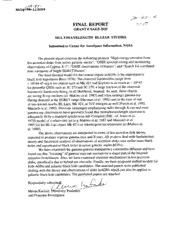
NASA Technical Reports Server (NTRS) 19980004824: Multiwavelength Blazar Studies PDF
Preview NASA Technical Reports Server (NTRS) 19980004824: Multiwavelength Blazar Studies
NA$ /q -11 ].3009 ,7/,/-e> -.. FINAL REPORT GRANT # NAGS-2025 MULTIWAVELENGTH BLAZAR STUDIES Submitted to Center for AeroSpace Information, NASA The present report concerns the following projects "High energy emission from hot accretion disks from active galactic nuclei"; "OSSE spectral timing and monitoring observations of Cygnus X-1"; "OSSE observations ofblazars"; and "Search for correlated time variations of bright EGRET blazars". The most favored model for the central engine inAGNs is the supermassive black hole hypothesis (Rees 1978). The observed luminosities range from - 10^44-45 erg/s for objects such as Mk 421 and Seyferts to as much as - 10^47 for powerful QSOs such as 3C 273 and 3C 279, a large fraction of the observed bolometric luminosity being, in all likelihood, beamed. As such, these objects are strong X-ray emitters (cf. Makino et al. 1987) and often undergo gamma-ray flaring detected at the EGRET range (Hartman et al. 1992) and in the case of one of two known nearby BL Lacs, Mk 421, at TeV energies as well (Punch et al. 1992, Macomb et al. 1995). Previous campaigns emphasizing radio through X-ray and even gamma-ray observations have generally found that themultiwavelength spectrum is adequately fit by a standard synchrotron self-Compton (SSC--cf. Jones et al. 1974) model of a relativistic jet (e.g. Makino et al. 1987 and Macomb et al. 1995 for the BL Lac object Mk 421 ) or inhomogeneous relativistic jet _Vlufson et al. 1990). The above observations are interpreted in terms of hot accretion disk theory, expected to produce copious gamma-rays and X-rays. All projects deal with fundamental theory and theoretical analysis of observations of accretion disks onto stellar mass black holes and supermassive black holes in active galactic nuclei _GNs). We have examined the gamma-gamma transparency constraints irblazars and have found out that "focusing" of gamma-rays can account for a major part of the beamed emission from blazars. Also, we have examined viscosity mechanisms in hot accretion disks, specifically due to hybrid ion viscosity. FinaIly, we have proposed unified models for both AGNs and galactic black hole candidates. The attached papers were published dealing with the theory and observations of disks inAGNs which can also be applied to galactic black hole candidates. The published papers are attached. Respectfully submitted, Menas Kafatos, b_fiiversity Profess_ and Principal Investigator
